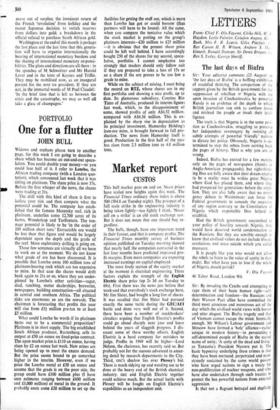One for a flutter
PORTFOLIO JOHN BULL
Widows and orphans please turn to another page, for this week I am going to describe a share which has become an out-and-out specu- lation. You could double your money—or you could lose half of it. I refer to Lonrho, the African trading company (with a London quo- tation), which announced last week that it was Sitting on platinum. The share price is now 37s. Before the first whisper of the news, the shares were trading at 21s.
The drill with this kind of share is first to isolate your risk and then compute what the potential could be. The company has estab- lished that the famous Merensky reef, rich in platinum, underlies some 12,700 acres of its farms, Wonderkop and Turffontein. The ton- nage potential is likely to be 'in the order of 100 million short tons.' Extractable ore would be less than that figure and would be largely dependent upon the depth and the grade of the reef. More exploratory drilling is going on. Those few sentences are virtually all we have to work on at the moment. We do not know what grade of ore has been discovered. It is possible that Lonrho owns 100 million tons of platinum-bearing rock which are too expensive to mine. In that case the shares would drift back again to 21s or so, where they are under- pinned by Lonrho's other activities—sugar, sisal, ranching, motor dealerships, breweries, newspapers, building construction—all situated in central and southern Africa. The political risks are enormous; so are the rewards. The chairman is forecasting that profits this year will rise from £3+ million pre-tax to at least S5 million.
What could Lonrho be worth if its platinum turns out to be a commercial proposition? Platinum is in short supply. The big established South African producer, Rustenburg, sells its output at £50 an ounce on fixed-price contract. The open market price is £110 an ounce, having risen by £2 an ounce last week. New mines are being opened up to meet the excess demand. But the price seems bound to go somewhat higher in the interim. However, even if we price the Lonrho metal at £50 an ounce and assume that the grade is on the poor side, the group could have £100 million plus (I have seen estimates ranging between £600 million and £1,000 million) of metal in the ground. It probably costs some £20 million to set up the facilities for getting the stuff out, which is more than Lonrho has got or could borrow (thus partners will hive to be found). All the same, when you compare the tentative value which the stock market is putting on the group's platinum interests—£20 million to £25 million —it is obvious that the present share price could be left well behind. I have accordingly bought 250 of the shares for my second, specu- lative, portfolio. I cannot emphasise too strongly that readers should only follow suit if they are prepared to take a loss of 15s or so a share if the ore proves to be too low a grade to mine. While on the subject of mining, I must bring the record on RTZ, whose shares are in my first portfolio and showing a nice profit, up to date. Its glamorous subsidiary, Conzinc Rio Tinto of Australia, produced its interim figures last week, which, to the disappointment of some, showed profits of only A$6.52 million, compared with A$6.36 million. This is ex- plained by the sharp rise in depreciation as its principal investment, Hamersley Holding's iron-ore mine, is brought forward to full pro- duction. The news from Hamersley itself is good. Production in the first half of the year has risen from 2.3 million tons to 4.8 million tons.






































 Previous page
Previous page